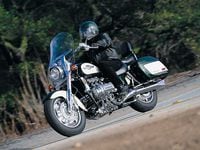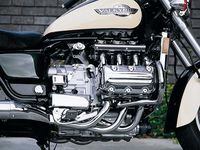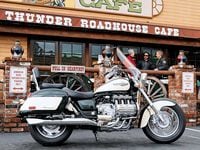After taking the cruising world by storm last year, Honda’s cruiser with a touring-bike engine has taken a step back towards its roots by becoming Honda’s touring cruiser with the touring-bike engine. The Valkyrie Tourer was such an obvious variation of the Valkyrie that Honda announced when the Valkyrie was introduced last year. However, the Tourer differs from the original only in the visible changes—just hard bags and a windshield bolted onto the standard Valkyrie. The accessories add $1500 to the monotone black bike and $1700 to the two-tone versions. The weight has increased by 36 pounds according to our scales and the gross vehicle weight rating (GVWR, the maximum permissible total weight of the bike and everything on it) has been upped a like amount. In other words, if you bought a Valkyrie last year, and realize that this Tourer is what you really want, you need only purchase the pieces and paint to suit to get it.
For those who slept through 1996, the Valkyrie is Honda’s flagship cruiser, based on the magnificent 1520cc opposed six-cylinder engine from the Gold Wing touring machine. Besides giving it a facelift for cruising duty, Honda also hot-rodded the engine a bit, with warmer cams, six 28mm carbs (instead of the Gold Wing’s two 34mm units), mechanically adjusted tappets instead of hydraulics, a redline bumped up to 6500 rpm and other tweaks. A unique exhaust system with six pipes peeking out from within the semi-fishtail mufflers is the final step in the powerplant upgrades. The transmission’s five ratios were shifted closer together, but shaft drive and hydraulic clutch operation were retained. The enormous engine, which has been sprinkled with chrome accents, rivets the attention of everyone who first sees the bike and also manufactures the kind of power to qualify it as a real musclebike.
To best frame that big engine, which is mounted solidly rather than in rubber, a new chassis was created. This frame not only exposes its diamond-style skeleton to the world but also has many changes from the pure tourer, such as relocating the 5.3-gallon fuel tank up in the conventional place rather than under the seat as in the Gold Wing. Inverted fork legs with the nick-prone 45mm inner tubes protected by chrome shields are among the most eye-catching chassis features. Especially when topped with the beautifully sculpted headlight.
Though Honda hasn’t developed as extensive an accessory line for the Valkyrie as has Harley for the Road King or Yamaha for the Royal Stars, the company does have a handful of bolt-ons, including studded upholstery, a rack, and several chrome trim items, including a guard rail set for the saddlebags.
This article was originally published in the April 1997 issue of Motorcycle Cruiser.



/cloudfront-us-east-1.images.arcpublishing.com/octane/ZFLEN5GEBJCXTJ72JLUO3QGHMQ.jpg)
/cloudfront-us-east-1.images.arcpublishing.com/octane/4RZQRGUTA5C2DMOEDGURJB4KRI.jpg)
/cloudfront-us-east-1.images.arcpublishing.com/octane/YJODDXEL2ZB5TENKPPN4BEYJAE.jpg)
/cloudfront-us-east-1.images.arcpublishing.com/octane/QEQQUZYNJFAIJB4DZFVFSNTCQ4.jpg)
/cloudfront-us-east-1.images.arcpublishing.com/octane/4OXL3PXHL5H3FAC7T5TCDX3S34.jpg)
/cloudfront-us-east-1.images.arcpublishing.com/octane/SUBBIQYDUNGJVHLA5TNHHRE3P4.jpg)
/cloudfront-us-east-1.images.arcpublishing.com/octane/4HLQB4W255HQ5GYOKOZNX7XKQA.jpg)
/cloudfront-us-east-1.images.arcpublishing.com/octane/F4VV6HPB55GIJABTHTQ2TM3ZQQ.jpg)
/cloudfront-us-east-1.images.arcpublishing.com/octane/DK7E3BPVEZAMXDKGXO4FY4JKA4.jpg)
/cloudfront-us-east-1.images.arcpublishing.com/octane/NAFNT7QSPNHSDHQ2SNCETHCRLI.jpg)
/cloudfront-us-east-1.images.arcpublishing.com/octane/VR253G637RGAHMEOM335EG2JMQ.jpg)
/cloudfront-us-east-1.images.arcpublishing.com/octane/SADSHCVUANAKVOZNPBEZW3AZNA.jpg)
/cloudfront-us-east-1.images.arcpublishing.com/octane/KFBYBE2JFVDGNFQU45I6ARG5WA.jpg)
/cloudfront-us-east-1.images.arcpublishing.com/octane/ZZNO6KMQ7RCILM3WVEPFUW44YI.jpg)
/cloudfront-us-east-1.images.arcpublishing.com/octane/ARDOSF3OGVCYTAPOKK66XYUEPY.jpg)
/cloudfront-us-east-1.images.arcpublishing.com/octane/VDADHHBS4NDN3LPASLBEPMN4GE.jpg)
/cloudfront-us-east-1.images.arcpublishing.com/octane/E3IGAU34MBBC3LIY6BEI5NVFKU.jpg)
/cloudfront-us-east-1.images.arcpublishing.com/octane/E7PLK4SZEFHXRNZVH2Z7GLZ2BY.jpg)
/cloudfront-us-east-1.images.arcpublishing.com/octane/FPHQ6O7HXFARVJ3L2ZYJIB4NBM.jpg)
/cloudfront-us-east-1.images.arcpublishing.com/octane/4XQZKUS5UJGY3IEBVERSNGGJ3U.jpg)
/cloudfront-us-east-1.images.arcpublishing.com/octane/A37VPL2PPRE3DGPBZI4V6N2IHE.jpg)
/cloudfront-us-east-1.images.arcpublishing.com/octane/JAF4HTUZ45GJBGM2MBOKB67DDE.jpg)
/cloudfront-us-east-1.images.arcpublishing.com/octane/JJ7MLEP34VBNPIJJKTZR472JOA.jpg)
/cloudfront-us-east-1.images.arcpublishing.com/octane/CC5ECSX765A7ZEKRA2QB363BME.jpg)